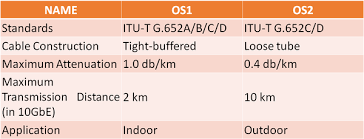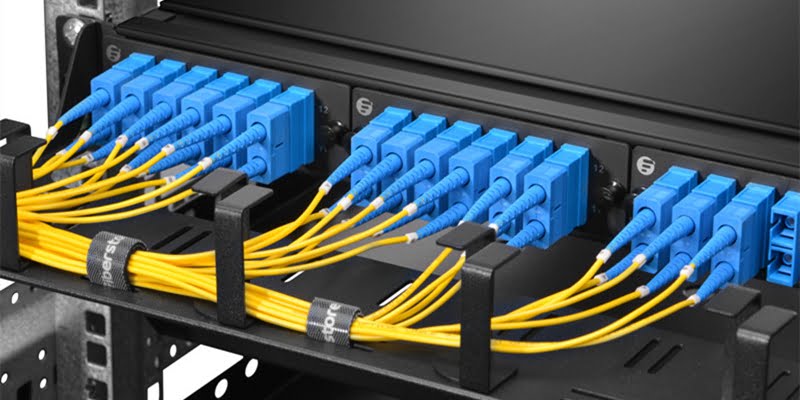OS1 Vs OS2 Fiber
In terms of the cable construction, OS1 is tight buffered while OS2 is loose tube. This determines they’ll be applied in different environment. OS1 single mode fiber is usually deployed in indoor applications such as schools, telecom exchanges and data center while OS2 single mode fiber is more appropriate for outdoor and universal loose tube solutions like street, underground and burial.
They’re different in maximum attenuation and transmission distance. The maximum attenuation and transmission distance for OS1 is 1.0db/km and 2km while for OS2 is 0.4db/km and 10km. And this determines that OS2 is much more expensive that OS1.
By default all our single mode fiber optic cable are OS2 fiber optic cable.

Single mode fiber cable is categorized into OS1 and OS2 fiber cable. These two kinds of fiber cables have different characteristics for diverse applications. OS2 SMF cables can not be connected with OS1 SMF cables, which may lead to poor signal performance. Therefore, it’s of great significance to figure out the difference between OS1 and OS2 when conducting deployments. Follow with this article to classify OS1 vs OS2.
OS1 vs OS2 SMF Cables, What Are Their Differences?
Standard
OS1 SMF cables are compliant with the specifications of ITU-T G.652, including ITU-T G.652A and ITU-T G.652B standards (conventional), ITU-T G.652C and G.652D standards (low-water-peak). However, OS2 SMF fiber cables are only compliant with ITU-T G.652C or ITU-T G.652D standards that are specifically applied to the low-water-peak fibers. These low-water-peak fibers are usually used for CWDM (Coarse Wavelength Division Multiplexing) applications. A new standard—G.657.A1 standard has published for bend-insensitive SMF cables for optimized performance and cost balance, some of the OS2 SMF fiber cables are accord with this standard.
Cable Construction
Embedded in a heavy polymer jacket, the OS1 cable is suitable for tight-buffered construction of indoor applications. For indoor applications, the jacketed fiber is generally enclosed, with a bundle of flexible fibrous polymer strength members like aramid in a lightweight plastic cover to form a simple cable. Whereas the OS2 cable is predominantly of a loose-tube construction, which is more appropriate for outdoor cases. A much more robust cable construction is required when deploying in some strenuous environments. The OS2 SMF is laid helically into semi-rigid tubes, allowing the cable to stretch without stretching the fiber itself in order to protect the fiber from tension.
Attenuation
The attenuation of an OS1 fiber cable is higher than an OS2 fiber cable. Typically speaking, the maximum attenuation of OS1 is 1.0db/km for 1310nm and 1550nm, while the numerical value of OS2 is 0.4db/km for 1310nm and 1550nm. Consequently, the maximum transmission distance of OS1 single mode fiber is 10 km, while the maximum transmission distance of OS2 single mode fiber can reach up to 200 km. Both OS1 and OS2 single mode fibers will allow speeds of 1 to 10GbE with varied transmission distances. Furthermore, the OS2 type of single mode fiber optic cable can be applied for 40G/100G Ethernet connections.
The specification table below will present the differences between OS1 and OS2 clearly.
| OS1 | OS2 | |
|---|---|---|
| Standards | ITU-T G.652A/B/C/D | ITU-T G.652C/G.657.A1 (part) |
| Cable Construction | Tight Buffer | Loose Tube |
| Application | Indoor | Outdoor |
| Attenuation | 1.0db/km | 0.4db/km |
| Max. Distance | 10 km | 200 km |
| Price | Low | High |
OS1 vs OS2 SMF Cables, How to Select?
When it comes to the cable selection between OS1 and OS2 single mode fiber, it’s essential to be clear that you are adopting these SMF cables for long-haul transmissions. Choose the proper cables based on your link length requirements.
OS1 optical fiber cables are applied for indoor network infrastructures, which are mainly deployed in internal building/campus networks, as well as internal cabling within telecommunication exchanges and data centers. Then OS1 cables are fit for your indoor application demands. OS2 optical fiber cables are more appropriate for outdoor and universal loose tube solutions, which would include external plant and most backhaul networks. When it is needed for outdoor network infrastructure, then OS2 is the way to go.

Why Should We Use OS2 Over OS1 Fiber?
After comparing the two fiber cables, it can be concluded that OS2 is more suitable for long-haul transmission by offering better performance with fewer losses. Considering this, why not adopt the optimal OS2 solutions to create a better performance for today’s high-speed data networks?
In fact, OS1 used to be the only one standard for single-mode fiber with the maximum link length for campus cabling around 10 km, which can no longer satisfy people’s increasing needs for longer link lengths. The OS2 single mode fiber optic cables are ideal for connecting 1G/10G/40G/100G Ethernet connections, meeting the requirements of high performance with long distances. As a result, more and more vendors tend to provide solutions with OS2 SMF cables for modern network applications.

Does the manufacture stilled make OS1 cable?
yes